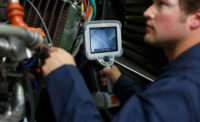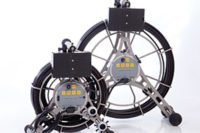This offshoot of visual inspection takes place without the operator or technician in the test area.
Visual inspection or visual testing (VT) is perhaps the simplest nondestructive testing (NDT) technique currently available, both operationally and in terms of interpretation. The data collected is a true image of the object under test and does not require time-consuming analysis to detect defects or cracks. Visual inspection equipment is easy-to-operate and the only skill required to perform this inspection technique successfully is the ability to spot defects or assess the integrity of the object with the naked eye.
Remote visual inspection (RVI), an offshoot of visual inspection, involves inspection of an object without the operator or technician present in the test area. Technologically and operationally, RVI is exactly the same as visual inspection with the only difference being usage of flexible tubes or fibers that bend around corners to enable inspection of inaccessible areas.
Equipment Overview
Visual inspection equipment consists of the distal tip (or inspection end) and the ocular end containing the eyepiece connected through a tube. This basic arrangement is common across different types of visual inspection equipment and has remained constant for over a century. However, based on the type of tube used and the imaging medium, visual inspection equipment can be broadly classified into borescope, fiberscope and videoscope.
Borescope – These were some of the first instruments available for visual inspection and consist of a stainless steel tube connecting the distal and the ocular ends. The tube contains a light guide which propels light into the distal end, illuminating the inspection area and the ocular end that contains the eyepiece used to view the area under inspection. A camera may be attached at the eye piece to record the images or view the inspection area on a larger screen. The tube is rigid and cannot be bent; hence, this equipment requires direct access to the object under test. Borescopes are low-priced equipment with a limited application base, priced in between $500 to $4,000.
Fiberscope – This is the refined version of a borescope. Fiberscopes eliminated the use of a rigid stainless steel tube, replacing it with a bundle of coherent optical fibers. Overall, this led to increased flexibility, thus giving birth to the field of remote visual inspection. The image quality in fiberscopes depends upon the number of fibers used: the more fiber strands, the better the quality of image acquired. A few strands of the fiber act as the light guide with a remote light source illuminating the inspection area. Similar to a borescope, it contains an eyepiece at the ocular end to view the image and a camera can be used to record or view the image on a large screen. The price range for fiberscope varies in between $3,000 to $12,000. Additionally, fiberscopes are also referred to as flexible borescopes.
Videoscope – Identified as the current generation of visual inspection equipment, these instruments contain either a charge coupled device (CCD) or a complementary metal-oxide-semiconductor (CMOS) camera chip close to the distal end of the scope, enhancing image quality significantly. The ocular end consists of a compact monitor to view the image transmitted by the camera. The biggest advantage of a videoscope is the immense upgrade in image quality and resolution.
Market Overview—What’s in store for the future?
In the recently published research study ‘Analysis of Nondestructive Test Equipment Market’, Frost & Sullivan estimates the total visual inspection market at $297.6 million in 2011. This market is expected to grow at an 8.1% compound annual growth rate (CAGR). This market accounted for 21.3% of the total NDT equipment market in 2011 and is expected to contribute 21.6% by 2016. The revenue growth rate expected for the visual inspection market is particularly high for a mature market. An important factor for this growth is expected to be higher adoption of RVI. With the technology continuously evolving, equipment manufacturers are able to provide better imaging quality and accuracy. For example, significant advancements have been made on the CMOS and CCD camera chips due to their use in consumer electronics, which has indirectly enhanced the image quality of videoscopes. In addition, robotics is being integrated with the RVI equipment to enable inspection of difficult-to-reach areas, such as the inside surface of oil and gas pipelines, which were previously considered impossible to visually inspect. These are just a few instances of the important advancements made over the past five years and provide a good indication of where the market is heading and the reasons for higher adoption of RVI.
What’s driving demand for RVI?
Although relative ease-of-use, cost-effectiveness and technology development are important drivers for uptake of RVI, the biggest factor aiding large scale market adoption is the lack of skilled technicians in the NDT industry. Over the past three to five years, the NDT industry has witnessed a decline of technicians with the appropriate skill-levels, leading to many end-user industries adopting RVI as one of the primary inspection techniques. On the other hand, this lack of skilled technicians in the industry has been complemented by an abundance of visual inspection certified technicians, due to the limited number of work and training hours required to gain a Level I, II and III certification. As a result, the number of technicians pursuing visual inspection certification has increased immensely over the past few years. Also, the American Society for Nondestructive Testing (ASNT) introduced certifications specific to RVI recognizing it as an independent NDT discipline, further indicating the growing importance of RVI as an NDT technique.
There are challenges associated with RVI
Visual inspection and RVI are expected to generate significant demand over the next three to five years due to the drivers mentioned above. However, there is a huge challenge associated with visual inspection: obtaining reliable and repeatable results. Research indicates that this continues to remain a key concern for customers. The inherent nature of the technique places immense scrutiny on the role of the operator or technician to accurately determine defects in the object under inspection. It is a well-known fact that human error can lead to highly variable and unreliable results. As a result, in certain mission critical applications it is rare that visual inspection is used as the stand-alone technology. Other NDT techniques such as ultrasonic testing, radiography testing and electromagnetic testing are preferred or RVI is used in conjunction with these NDT techniques to ensure high reliability.
However, the introduction of certification specific to RVI by ASNT is viewed as an important development in the NDT industry which is expected to dispel fears regarding the reliability and accuracy of this technology. In addition, market participants are investing in R&D to further enhance the final quality of the image, thus simplifying their interpretation.
Where is the demand being generated?
From an application perspective, visual inspection can be broadly classified into direct and remote. As discussed earlier, inspection using borescopes can be classified under direct visual inspection, and inspection using fiberscopes and videoscopes under remote visual inspection. Direct visual inspection has limited applications and finds maximum utility in the manufacturing industry. On the other hand, RVI has significantly expanded the scope of applications visual inspection can cater to since the equipment enables inspection of inaccessible areas. For instance, inspection of turbine blades in aircraft engines and of large steam and gas turbines in the power generation industry could not be performed using traditional rigid borescopes. With the introduction of fiberscopes and videoscopes, however, visual inspection of the turbine blades became a possibility. Other applications for RVI include inspection of aircraft fuselage, and small diameter piping in the oil and gas and process industries.
Frost & Sullivan estimates that power generation and aerospace, military and defense are the biggest end users of visual inspection accounting for 25.3 and 23.1% respectively in 2011. Integration of robotics with RVI equipment has enabled development of pipe crawlers which aid in inspection of oil and gas pipelines, which is expected to benefit the adoption of RVI in oil and gas according to trends noted by Frost & Sullivan. The oil and gas market accounted for 20.9% of the total visual inspection market in 2011; however, this industry is expected to contribute 21.3% to the total visual inspection market revenues by 2016 with an expected 8.5% CAGR. (see pie chart)
Competitive Overview
The competition in the visual inspection and RVI market is significantly concentrated. A review of the ASNT visual inspection equipment buyers guide exhibits 40 manufacturers. Of these, the most important companies include GE Measurement and Control Solutions, Olympus NDT, and Karl Storz. GE has made significant investments over the past five years to develop a new measurement technique for RVI equipment— 3-D phase measurement. This technique is a crossover from the optical metrology market and is expected to significantly improve the accuracy of the final images. Olympus NDT has added new equipment to its RVI product line IPLEX, introducing an ultra-portable handheld instrument along with an instrument with articulation.
Conclusion
Since the introduction of borescopes nearly a century ago, the technology has evolved significantly. Development of fiberscopes and videoscopes has significantly expanded the application base of visual inspection due to its ability of inspecting inaccessible areas. Further development in enhancing the image quality and accuracy has aided market adoption. RVI is undeniably an important development in the NDT industry and its recognition as an independent NDT technique by ASNT has supplemented this importance. Over the next three to five years it is expected that RVI will generate significant revenue and consistent technology enhancements is an important indication of the importance of RVI as part of the product portfolio of NDT equipment vendors.




